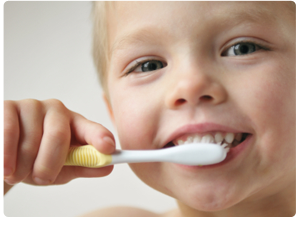A child's first visit to the pediatric dentist should be enjoyable and positive. The more you and your child know about the first visit, the better you will feel. Children are not born with a fear of the dentist, but they can fear the unknown. Our office makes a practice of using pleasant, non-frightening, simple words to describe your child's first dental visit and treatment. We want you to feel at ease from the moment your family arrives at our office.
According to the American Academy of Pediatric Dentistry (AAPD), children should visit the dentist by their first birthday. It is important that your child's newly-erupted teeth (erupting at 6-12 months of age) receive proper dental care and benefit from proper oral hygiene habits right from the beginning.
To prepare for your child's visit, we have created an activity kit to familiarize your child with their teeth and help them look forward to their dental visit.
» Getting to know your teeth is fun! Get comfortable with your teeth with our Dynamite Dental Fun Kit.
When New Teeth Arrive
Your child's first tooth erupts between ages 6-12 months and the remainder of their 20 primary or "baby" teeth typically erupt by age 3. During this time, gums may feel tender and sore, causing your child to feel irritable. To help alleviate this discomfort, we recommend that you soothe the gums by rubbing a clean finger or a cool, wet cloth across them. You may also choose to make use of a teething ring.
Your child's primary teeth are shed at various times throughout childhood, and their permanent teeth begin erupting at age 6 and continue until age 21. Adults have 28 permanent teeth, or 32 including wisdom teeth.
Adopting Healthy Oral Hygiene Habits
 As new teeth erupt, examine them every two weeks for lines and discoloration caused by decay. Remember that sugary foods and liquids can attack a new tooth, so take care that your child brushes their teeth after feeding or eating. We recommend brushing four times a day for optimal oral hygiene: after breakfast, after lunch, after dinner, and at bedtime. Brushing can be fun, and your child should brush as soon as the first tooth arrives. When a baby's tooth erupts, parents should brush the tooth with a soft-bristled toothbrush and a pea-sized amount of fluoridated toothpaste. We suggest reviewing proper tooth brushing procedures with your child.
As new teeth erupt, examine them every two weeks for lines and discoloration caused by decay. Remember that sugary foods and liquids can attack a new tooth, so take care that your child brushes their teeth after feeding or eating. We recommend brushing four times a day for optimal oral hygiene: after breakfast, after lunch, after dinner, and at bedtime. Brushing can be fun, and your child should brush as soon as the first tooth arrives. When a baby's tooth erupts, parents should brush the tooth with a soft-bristled toothbrush and a pea-sized amount of fluoridated toothpaste. We suggest reviewing proper tooth brushing procedures with your child.
Flossing is also a part of good oral hygiene habits, and your doctor will discuss with you the right time to start flossing.
If you notice signs of decay, contact your dentist immediately.
Preventing Tooth Decay
Tooth decay is preventable. Tooth decay is caused by sugars left in your mouth that turn into an acid which can break down your teeth. Children are at high risk for tooth decay for a simple reason — many children and adolescents tend to be lax in their oral hygiene habits. Proper brushing and flossing routines combined with regular dental visits help keep tooth decay away. A low-sugar diet also helps keep tooth decay at bay.
Your child should visit the dentist every 6 months for regular dental cleanings and checkups. We recommend fluoride treatments twice a year along with cleanings to keep teeth their strongest. Tooth sealants are also recommended because they "seal" the deep grooves in your child's teeth, preventing decay from forming in these hard-to-reach areas. Sealants last for several years, but will be monitored at your regular checkups.
